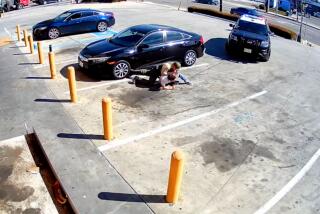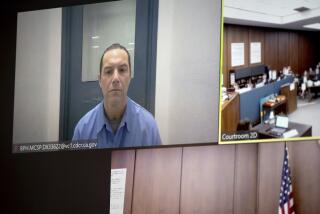Judge Recommends Lisker’s Claim Proceed
Concluding that Bruce Lisker’s conviction for the 1983 slaying of his mother has been “effectively dismantled,” a federal magistrate recommended Thursday that Lisker be allowed to proceed with his claim of innocence in federal court.
In a 57-page report, U.S. Magistrate Judge Ralph Zarefsky wrote that he had “no confidence” in the guilty verdict rendered at Lisker’s 1985 trial in Van Nuys and that, based on new evidence, “no reasonable juror” would be likely to convict him today.
Zarefsky submitted the report to U.S. District Court Judge Virginia A. Phillips with the recommendation that she adopt its findings and send the case back to his courtroom so that Lisker can present constitutional claims for overturning his conviction.
Judges are not bound by magistrate judges’ recommendations but often follow them, particularly when they are backed up by extensive evidentiary findings.
Because Lisker, 40, missed a deadline nine years ago for filing a writ of habeas corpus, his attorneys were required to establish the likelihood of his innocence in order to have Zarefsky waive the deadline. After hearing evidence from both sides in the case last fall, Zareksky found that his attorneys had met that test.
Legal observers described the development as significant.
“It’s huge,” said Loyola law professor Laurie Levenson. “To me, it means the jailhouse doors may be slowly starting to open.”
Levenson said the judge’s strongly worded report should put “enormous pressure” on Los Angeles County Dist. Atty. Steve Cooley to reassess the case against Lisker.
Cooley was not immediately available for comment.
Deputy Atty. Gen. Robert Breton, who has been defending Lisker’s conviction, said he needed more time to absorb the findings.
“We are still carefully reading the report and recommendation,” Breton said. “I have no further comment at this time.”
William Genego, one of Lisker’s attorneys, was elated. “Bruce Lisker has waited 22 years to get his first taste of justice,” Genego said. “We’re glad it’s finally come, even though it’s long overdue.”
Phillip Rabichow, the prosecutor who secured Lisker’s conviction, said he wants justice to be served and that, if a mistake was made, he wants it to be corrected.
“If he’s innocent, he should be released,” he said.
Lisker’s mother, Dorka, 66, was fatally beaten and stabbed in her Sherman Oaks home on March 10, 1983. Bruce claimed that he came home and found his mother bloody and near death in the entry hall of the home. He called paramedics to come to her aid.
When police arrived, Lisker told officers that he had found the front door locked and saw no sign of his mother. He said he went to the backyard and began looking through windows and that he saw his mother’s head through a patio sliding glass door. Lisker said he broke into the house through a kitchen window and tried to provide first aid before paramedics arrived.
Police were immediately suspicious of the frizzy-haired teen, who had a history of drug abuse and fighting with his mother. They did not believe that he would have been able to see her head through the sliding glass door, as he claimed. They were also dubious of his claim of entering the house through the kitchen window.
After providing a detailed statement to LAPD Det. Andrew Monsue, Lisker was arrested.
The Times, as part of a seven-month investigation into the case, reported a year ago that Rabichow, now retired, had acknowledged after a recent visit to the family’s home that Lisker might have been able to see his mother’s prone body, as he had claimed.
Based on The Times’ investigation and other evidence, Rabichow said he had reasonable doubt about Lisker’s guilt.
While police and prosecutors had long theorized that Lisker had killed his mother after she caught him stealing money from her purse -- $150 missing from her wallet was never found, they said -- The Times unearthed an inventory report stating that $120 had been tucked inside a wallet in the purse all along.
In his report, Zarefsky wrote that the evidence put forth at a December hearing “effectively dismantled the case the prosecution presented at trial.”
Rabichow’s claim at trial that Lisker could not possibly have seen his mother’s body through the rear windows of the home was refuted.
Bloody shoeprints found in the home that Rabichow said had been left by Lisker “were not made by [Lisker’s] shoes,” Zarefsky wrote.
Zarefsky said that at least some of the $150 that Rabichow said was missing from Dorka Lisker’s purse “appears to have remained” in the handbag.
The magistrate judge also noted that new evidence with regard to the prosecution’s reliance on a jailhouse informant, Robert Hughes, who testified at trial that Lisker had confessed to him that he had killed his mother, “was even less than it appeared at trial.”
Finally, Zarefsky said that Monsue never sufficiently investigated another suspect, Michael Ryan, a friend of Lisker’s, who lied about his whereabouts at the time of the slaying.
Were a jury to consider the case in light of all the new evidence put forth by Lisker’s attorneys, Zarefsky wrote, it would “know that there is essentially no evidence of [Lisker’s] guilt” beyond the confessions he ultimately recanted, which were “self-serving when they were made and unaccompanied by verifying details.”
” ... There is a strong suggestion that someone else was responsible for the crime,” Zarefsky said. “In such circumstances, it is more probable than not that no reasonable juror would find [Lisker] guilty of murder beyond a reasonable doubt.”
More to Read
Start your day right
Sign up for Essential California for news, features and recommendations from the L.A. Times and beyond in your inbox six days a week.
You may occasionally receive promotional content from the Los Angeles Times.







